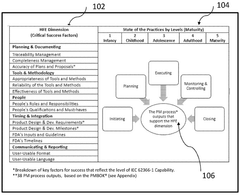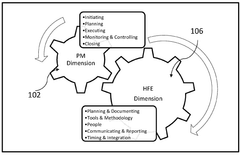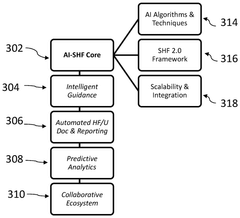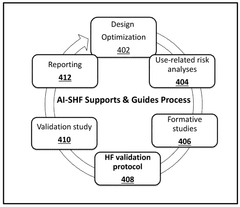Human Factors Research For Wearable Biofuel Acceptance
Wearable Biofuel Technology Background and Objectives
Wearable biofuel technology represents a revolutionary approach to powering electronic devices by harnessing energy directly from the human body. This emerging field sits at the intersection of biotechnology, materials science, and wearable computing, offering potential solutions to the persistent challenge of energy supply in portable and wearable devices. The evolution of this technology can be traced back to early research on biofuel cells in the 1960s, but significant advancements in miniaturization, biocompatibility, and energy efficiency over the past decade have made wearable applications increasingly viable.
The fundamental principle behind wearable biofuel technology involves converting biological substances present in human bodily fluids—such as sweat, tears, or interstitial fluid—into electrical energy through enzymatic reactions. Glucose and lactate are particularly promising fuel sources due to their natural abundance in the human body and relatively high energy density. Recent technological breakthroughs have enabled the development of flexible, stretchable, and skin-compatible biofuel cells that can be integrated into various wearable form factors.
Current research trajectories indicate a shift from laboratory prototypes to practical applications, with increasing focus on enhancing power output, longevity, and user comfort. The technology has evolved from rigid implantable devices to flexible, non-invasive systems that can be incorporated into everyday wearables such as watches, patches, and smart textiles. This progression aligns with broader trends in wearable technology toward seamless integration with the human body and minimal user intervention.
The primary objectives of wearable biofuel technology research are multifaceted. First, to achieve sufficient power density to support modern wearable devices, targeting at least 1-5 mW/cm² for practical applications. Second, to ensure biocompatibility and safety for long-term wear, addressing potential skin irritation and toxicity concerns. Third, to develop manufacturing processes that enable cost-effective mass production, bringing the technology from specialized applications to consumer markets.
Additionally, research aims to optimize the user experience by designing systems that operate reliably under various physiological conditions and activity levels. This includes addressing challenges related to fluctuations in biofuel availability during different metabolic states and environmental conditions. The ultimate goal is to create self-powered wearable systems that eliminate the need for conventional batteries, thereby reducing electronic waste and enabling truly continuous operation of health monitoring and other wearable applications.
Human factors research specifically focuses on understanding and improving user acceptance of this novel technology, recognizing that technical feasibility alone will not guarantee market success without addressing psychological, social, and practical barriers to adoption.
Market Analysis for Wearable Biofuel Applications
The wearable biofuel market represents a revolutionary intersection of biotechnology, energy harvesting, and wearable technology. Current market analysis indicates significant growth potential, with the global wearable technology market expected to reach $265 billion by 2026 and the biofuel sector simultaneously expanding. The convergence of these markets creates a unique opportunity for wearable biofuel applications.
Consumer demand for sustainable energy solutions has risen dramatically, with 73% of global consumers expressing willingness to change consumption habits to reduce environmental impact. This trend particularly resonates with younger demographics, who demonstrate higher acceptance rates for wearable technology integrated with sustainable energy solutions. The healthcare wearables segment shows particular promise, as continuous monitoring devices require reliable power sources that traditional batteries cannot efficiently provide.
Market segmentation reveals several key application areas for wearable biofuel technology. Medical monitoring devices represent the largest potential market segment, with glucose-powered biofuel cells showing particular promise for diabetic monitoring applications. Military and emergency services form another substantial segment, where reliable, lightweight power sources for field equipment are highly valued. The consumer fitness market presents a third significant opportunity, though adoption barriers related to aesthetics and comfort are more pronounced in this segment.
Geographic distribution of market potential varies considerably. North America currently leads in research investment and consumer readiness, with approximately 42% of early adopters located in this region. The Asia-Pacific market shows the fastest growth trajectory, driven by rapid technological adoption in countries like Japan, South Korea, and China, coupled with increasing environmental consciousness.
Competitive analysis reveals that established medical device manufacturers are actively exploring wearable biofuel integration, while several specialized startups have emerged focusing exclusively on this technology. Strategic partnerships between biofuel developers and wearable technology companies are becoming increasingly common, indicating market recognition of the synergistic potential.
Consumer acceptance factors significantly impact market potential. Research indicates that perceived benefits must clearly outweigh concerns about bodily integration and biocompatibility. Price sensitivity varies by application, with medical applications demonstrating higher willingness-to-pay than consumer applications. The aesthetic impact of wearable biofuel cells remains a significant market barrier that requires innovative design solutions to overcome.
Regulatory considerations will substantially influence market development timelines. Medical applications face more rigorous approval processes but benefit from clearer regulatory pathways compared to consumer applications, which may face uncertain classification under existing regulatory frameworks.
Current Challenges in Human-Biofuel Interface
Despite significant advancements in wearable biofuel cell technology, the human-biofuel interface presents several critical challenges that impede widespread adoption. The primary obstacle remains the biocompatibility of materials used in these devices. Current electrode materials and enzymatic components can trigger immune responses, skin irritation, or allergic reactions when in prolonged contact with human skin or bodily fluids, limiting the practical duration of wear.
Stability and longevity issues further complicate the human-biofuel interface. The enzymatic catalysts typically employed in biofuel cells experience activity degradation over time when exposed to varying body conditions such as temperature fluctuations, pH changes, and the presence of inhibitory compounds in sweat or interstitial fluid. This degradation significantly reduces power output reliability, creating inconsistent user experiences.
User comfort represents another substantial challenge. Current wearable biofuel cell designs often lack flexibility and ergonomic considerations, resulting in devices that feel intrusive or uncomfortable during daily activities. The rigid components and connection points create pressure points on the skin, while the weight distribution of current prototypes can cause user discomfort during extended wear periods.
Power density limitations at the human-biofuel interface continue to constrain practical applications. Despite theoretical potential, the actual power generated from human biofluids remains insufficient for many high-demand wearable applications. The interface between biological fluids and electrode surfaces experiences efficiency losses due to diffusion limitations, biofouling, and incomplete fuel utilization.
Data privacy and security concerns emerge as biofuel cells increasingly integrate with health monitoring systems. These devices potentially collect sensitive physiological data through their operation, raising questions about data ownership, storage security, and unauthorized access. The regulatory framework for such hybrid energy-monitoring devices remains underdeveloped in most jurisdictions.
Psychological acceptance factors present subtle but significant barriers. Users express concerns about devices that "feed" on bodily substances, revealing deep-seated psychological barriers related to bodily autonomy and technological integration with biological processes. Focus group studies indicate that even when technical performance is adequate, these psychological factors can determine adoption decisions.
Standardization challenges persist across the human-biofuel interface ecosystem. The lack of unified testing protocols, safety standards, and performance metrics specific to wearable biofuel cells creates inconsistency in product development and evaluation. This absence of standardization complicates regulatory approval pathways and slows industry-wide innovation.
Current Human Factors Solutions for Biofuel Wearables
01 Wearable biofuel cell technologies
Wearable biofuel cells represent an innovative approach to power generation for wearable devices. These cells convert biochemical energy from bodily fluids like sweat or interstitial fluid into electrical energy. The technology typically involves enzymatic reactions on electrodes that can be integrated into flexible, skin-conforming materials. These biofuel cells offer advantages such as renewable energy generation, biocompatibility, and the potential for continuous power supply without the need for traditional battery recharging.- Wearable biofuel cell technologies: Wearable biofuel cells represent a significant advancement in sustainable energy generation for portable and wearable devices. These cells convert biological substances like sweat, glucose, or other bodily fluids into electrical energy through enzymatic reactions. The technology enables continuous power generation while being worn, making it suitable for various wearable health monitoring devices and other electronic wearables. These systems are designed to be flexible, lightweight, and comfortable for the user while maintaining efficient energy conversion.
- User acceptance and interface design: The acceptance of wearable biofuel technology depends significantly on user interface design and overall user experience. Factors affecting acceptance include comfort, aesthetic appeal, ease of use, and integration with existing devices or systems. Successful wearable biofuel devices incorporate intuitive interfaces that provide feedback on energy generation and usage. Additionally, designs that minimize visibility or integrate seamlessly with clothing or accessories tend to have higher acceptance rates among potential users.
- Biofuel harvesting from bodily fluids: Advanced methods for harvesting biofuels from bodily fluids such as sweat, tears, or interstitial fluid have been developed for wearable applications. These techniques involve specialized membranes, microfluidic channels, and enzymatic systems that can efficiently extract and process biological compounds. The harvesting systems are designed to be non-invasive or minimally invasive while maximizing energy extraction efficiency. Some innovations include continuous harvesting mechanisms that can function during various activities and physiological states.
- Integration with health monitoring systems: Wearable biofuel cells are increasingly being integrated with health monitoring systems, creating dual-purpose devices that both generate power and track physiological parameters. These integrated systems can monitor glucose levels, electrolyte balance, metabolic activity, or other health indicators while simultaneously using these same biological substances as fuel sources. This synergistic approach enhances the utility of wearable technology while potentially reducing the overall device footprint and power requirements.
- Environmental and sustainability aspects: The environmental and sustainability benefits of wearable biofuel cells contribute significantly to their acceptance and adoption. These devices utilize renewable biological resources as fuel, reducing dependence on traditional batteries that contain toxic materials and require frequent replacement. The biodegradability of components, reduced electronic waste, and lower carbon footprint associated with manufacturing and disposal are key advantages. Research focuses on developing fully sustainable materials for all components of wearable biofuel systems to maximize their environmental benefits.
02 User interface and acceptance factors for biofuel wearables
The acceptance of wearable biofuel technologies depends significantly on user interface design and user experience factors. This includes considerations such as comfort during wear, aesthetic appeal, intuitive controls, and seamless integration with existing devices or applications. Research indicates that user acceptance increases when wearable biofuel devices provide clear feedback on energy generation, maintain consistent performance, and do not require significant lifestyle adjustments. The social perception of wearing such devices also plays a crucial role in their widespread adoption.Expand Specific Solutions03 Integration of biofuel cells with health monitoring systems
Wearable biofuel cells can be integrated with health monitoring systems to create multifunctional devices. These integrated systems can simultaneously harvest energy from bodily fluids while analyzing their composition for health biomarkers. This dual functionality enhances the value proposition for users, potentially increasing acceptance rates. The integration allows for continuous health monitoring without the need for separate power sources, making the technology more convenient and less intrusive for users while providing valuable health data.Expand Specific Solutions04 Environmental and sustainability aspects of wearable biofuels
The environmental benefits of wearable biofuel cells contribute significantly to their acceptance. These devices utilize renewable biological resources as fuel, reducing dependency on traditional batteries that contain toxic materials and present disposal challenges. The sustainability narrative around wearable biofuels includes their reduced carbon footprint, biodegradability of components, and potential for circular economy applications. Marketing these environmental benefits has been shown to positively influence consumer acceptance, particularly among environmentally conscious demographics.Expand Specific Solutions05 Market adoption strategies for wearable biofuel technologies
Successful market adoption of wearable biofuel technologies requires strategic approaches addressing both technical and social barriers. These strategies include targeted education about the technology's benefits, partnerships with established wearable device manufacturers, demonstration of reliability through extended field testing, and addressing privacy concerns related to biological data collection. Phased introduction approaches have shown promise, beginning with niche applications where conventional power sources are problematic before expanding to mainstream consumer markets. Pricing strategies that highlight long-term cost savings over traditional battery-powered devices also enhance acceptance.Expand Specific Solutions
Key Industry Players and Competitive Landscape
The wearable biofuel technology market is currently in an early growth phase, characterized by significant research and development activities but limited commercial deployment. The global market for wearable biofuels is projected to expand as sustainable energy solutions gain traction, with estimates suggesting potential growth to $500 million by 2030. From a technical maturity perspective, the field remains predominantly experimental, with key players demonstrating varying levels of advancement. Samsung Electronics and Google are leveraging their consumer electronics expertise to integrate biofuel cells into wearable devices, while specialized companies like Gevo and Morion NanoTech focus on developing novel biofuel materials. Academic institutions including California Institute of Technology and University of Washington are conducting foundational human factors research to address acceptance barriers, collaborating with industry leaders like Philips to bridge the gap between laboratory innovation and consumer adoption.
Samsung Electronics Co., Ltd.
University of Washington
Critical Patents in Wearable Biofuel User Experience
- The integration of artificial intelligence (AI) technologies, including machine learning, neural networks, and the Internet of Things (IoT), with the Successful Human Factors (SHF) 2.0 framework to create an adaptive and scalable AI-SHF system that enhances usability engineering, risk mitigation, and regulatory compliance.
- A monitoring apparatus comprising experiment nodes, control nodes, and co-ordination means that enables real-time data collection and integration of user interactions, physiological measurements, and expert observations across multiple nodes, facilitating coordinated analysis and adaptive simulation configurations.
Regulatory Framework for Body-Worn Energy Harvesting
The regulatory landscape for body-worn energy harvesting technologies, particularly wearable biofuel cells, presents a complex framework that spans multiple jurisdictions and oversight bodies. Currently, these technologies exist in a regulatory gray area between medical devices, consumer electronics, and biohazardous materials management, creating significant compliance challenges for manufacturers and researchers.
In the United States, the FDA has begun developing preliminary guidelines for biofuel cells that interface directly with human bodily fluids, classifying them under Class II medical devices when they serve diagnostic or therapeutic functions. However, purely energy-harvesting applications without explicit medical claims fall under less stringent regulatory pathways, creating potential loopholes that industry stakeholders are actively navigating.
The European Union's approach differs substantially through the Medical Device Regulation (MDR) framework, which explicitly addresses biologically-derived energy sources. Any device utilizing human metabolites for power generation must undergo rigorous biocompatibility testing and demonstrate long-term safety profiles. Additionally, the EU's REACH regulations impose strict requirements on chemical components used in these systems, particularly catalysts and membrane materials that may contact skin or bodily fluids.
Biosafety regulations present another critical dimension, with most jurisdictions requiring manufacturers to demonstrate that harvested biological materials cannot pose contamination risks. This includes protocols for disposal, sterilization between uses, and safeguards against microbial growth within the fuel cell matrices. The International Electrotechnical Commission (IEC) has established working groups specifically addressing safety standards for bio-integrated power sources, though finalized standards remain under development.
Privacy considerations have emerged as an unexpected regulatory concern, as biofuel cells that monitor metabolic byproducts could potentially reveal health information about users. Several jurisdictions now require data protection impact assessments for devices that may inadvertently collect biological data through their power generation mechanisms.
Emerging markets present varying regulatory approaches, with Japan implementing a specialized approval pathway for "bio-harmonious technologies" that includes wearable biofuel cells, while China has incorporated these technologies into its broader strategic bioeconomy framework with expedited approval processes for domestically developed systems.
The fragmented nature of these regulations creates significant market entry barriers and compliance costs. Industry consortia have begun advocating for harmonized international standards specific to body-worn energy harvesting technologies to facilitate innovation while maintaining appropriate safety oversight. Regulatory science in this domain continues to evolve as the technology matures and real-world implementation data becomes available.
Psychological Barriers to Biofuel Wearable Adoption
The adoption of wearable biofuel technology faces significant psychological barriers that extend beyond mere technical concerns. Consumer psychology research indicates that bodily autonomy and perceived invasion of personal space represent primary obstacles to acceptance. Many potential users express discomfort with the concept of devices that extract biological materials—such as sweat, interstitial fluid, or other bodily substances—even when these processes are painless and minimally invasive. This reaction stems from deeply rooted psychological boundaries regarding bodily integrity that technology developers often underestimate.
Cultural factors substantially influence these psychological barriers, with significant variations observed across different societies. Studies comparing Eastern and Western attitudes toward biofuel wearables reveal that collectivist societies demonstrate greater willingness to adopt such technologies when framed as contributing to community energy independence, while individualistic societies respond better to personal benefit narratives. Religious and philosophical beliefs regarding the body as sacred or inviolable further complicate acceptance patterns in certain demographics.
The "disgust factor" presents another substantial psychological barrier. Research in sensory psychology demonstrates that users report heightened disgust responses when confronted with devices that visibly collect or process bodily fluids. This reaction persists even when users intellectually understand the safety and hygiene protocols in place. Aesthetic design interventions that conceal the collection and conversion processes have shown promise in mitigating these responses, suggesting that visual cues significantly impact psychological acceptance.
Trust deficits regarding data security and health implications constitute additional psychological barriers. Potential users express concerns about who might access their biometric data and how it might be used beyond energy generation. The intimate nature of biofuel collection creates heightened privacy anxieties compared to conventional wearable technology. Furthermore, despite scientific evidence supporting safety, persistent concerns about long-term health effects from continuous biofuel extraction represent significant adoption obstacles.
Cognitive biases, particularly the status quo bias and loss aversion, further impede acceptance. Users demonstrate reluctance to transition from familiar energy sources to novel biological alternatives, perceiving greater potential risks than benefits. Market research indicates that early adopters of wearable biofuel technology typically score lower on disgust sensitivity scales and higher on technology openness metrics, suggesting specific psychological profiles may be more receptive to initial adoption phases.







